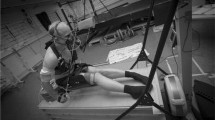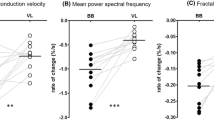Summary
Seven male elite strength-trained athletes (SA) from different weight categories, six elite sprinters (SPA) and seven elite endurance-trained athletes (EA) volunteered as subjects for examination of their muscle cross-sectional area (CSA), maximal voluntary isometric force, force-time and relaxation-time characteristics of the leg extensor muscles. The SA group demonstrated slightly greater CSA and maximal absolute strength than the SPA group, while the EA group demonstrated the smallest values both in CSA and especially in maximal strength (p<0.05). When the maximal forces were related to CSA of the muscles, the mean value for the SA group of 60.8±10.0 N·cm−2 remained slightly greater than that recorded in the SPA group 55.0±3.1 N·cm−2 and significantly greater (p<0.05) than that recorded in the EA group 49.3±4.0 N·cm−2. The mean value in the SPA was also significantly greater (p<0.05) than that of the EA group. The isometric force-time curves differed between the groups (p<0.05−0.01) so that the times taken to produce the same absolute force were the shortest in the SPA group and the longest in the EA group. With force expressed as a percentage of the maximum, the force-time curves showed that the SPA group demonstrated still shorter times to a given value (p<0.05), especially at the lower force levels, than the other two groups. With regard to the differences in force production per CSA and in the shape of the force-time curves, the present findings may be explained by possible differences both in the rate and the amount of neural activation of the muscles and/or in the qualitative characteristics of the muscle tissue itself. The present findings characterize the very specific nature of high resistance strength-, sprint- and endurance-training stimuli over a very prolonged period of time.
Similar content being viewed by others
References
Durnin J, Rahaman M (1967) The assessment of the amount of fat in the human body from measurements of skinfold thickness. Br J Nutr 21:681–689
Gollnick P (1981) Adaptations in skeletal muscle in response to training. In: Ishiko T (ed) Physical fitness research. Proceedings of 1981 International Council on Physical Fitness Research, Tokyo, ICPFR, pp 21–31
Häkkinen K (1986) Training and detraining adaptations in electromyographic, muscle fibre and force production characteristics of human leg extensor muscles with special reference to prolonged heavy resistance and explosive type strength training. Studies in sport, physical education and health. (Thesis), University of Jyväskylä
Häkkinen K (1989) Muscle cross-sectional area, force production and relaxation characteristics in males, females, male and female strength athletes: In: Högtors (ed) proceedings of the 3rd Biomechanics Seminar, Centre for Biomechanics, Chalmers University of Technology and Göteborg University, Göteborg, pp 144–161
Häkkinen K, Komi PV (1983) Electromyographic changes during strength training and detraining. Med Sci Sports Exerc 15:455–460
Häkkinen K, Viitasalo JT, Komi PV (1980) Die Wirkung unterschiedlich kombinierter konzentrischer und exzentrischer Muskelarbeit auf Kraft-Zeit-Merkmale der Beinstreck-Muskulatur. Leistungssport 10:374–381
Häkkinen K, Alen M, Komi PV (1984) Neuromuscular, anaerobic and aerobic performance characteristics of elite power athletes. Eur J Appl Physiol 53:97–105
Häkkinen K, Alen M, Komi PV (1985a) Changes in isometric force- and relaxation-time, electromyographic and muscle fiber characteristics of human skeletal muscle during strength training and detraining. Acta Physiol Scand 125:573–600
Häkkinen K, Komi PV, Alen M (1985b) Effect explosive type strength training on isometric force- and relaxation-time, electromyographic and muscle fibre characteristics of leg extensor muscles. Acta Physiol Scand 125:587–600
Hickson R (1980) Interference of strength development by simultaneously training for strength and endurance. Eur J Appl Physiol 45:255–263
Hunter G, Demment R, Miller D (1987) Development of strength and maximum oxygen uptake during simultaneous training for strength and endurance. J Sports Med 27:269–275
Ikai M, Fukunaga T (1968) Calculation of muscle strength per unit cross-sectional area of human muscle by means of ultrasonic measurement. Int Z Angew Physiol Einschl Arbeitsphysiol 26:26–32
Ikai M, Fukunaga T (1970) A study on training effect on strength per unit cross-sectional area of muscle by means of ultrasonic measurement. Int Z Angew Physiol Einschl Arbeitsphysiol 28:173–180
Komi PV (1973) A new electromechanical ergometer. In: Hauser G, Mellercowicz H (eds) 3rd Internationales Seminar für Ergometrie, Ergon, Berlin, pp 173–176
Komi PV (1984) Physiological and biomechanical correlates of muscle function: effects of muscle structure and stretch-shortening cycle on force and speed. Exerc Sport Sci Rev 12:81–121
Komi PV (1986) Training of muscle strength and power: interaction of neuromotoric, hypertrophic, and mechanical factors. Int J Sports Med [Suppl] 7:10–15
MacDougall J (1986) Morphological changes in human skeletal muscle following strength training and immobilization. In: Jones N, McCartney N, McComas A (eds) Human muscle power. Human Kinetics, Champaign, USA, pp 263–288
Maughan RJ, Watson JS, Weir J (1983) Relationship between muscle strength and muscle cross-sectional area in male sprinters and endurance runners. Eur J Appl Physiol 50:309–318
Moritani T, DeVries H (1979) Neural factors versus hypertrophy in the time curse of muscle strength gain. Am J Phys Med 58:115–130
Ryushi T, Häkkinen K, Kauhanen H, Komi PV (1988) Muscle fiber characteristics, muscle cross-sectional area and force production in strength athletes, physically active males and females. Scand J Sports Sci 10:7–15
Sale D (1986) Neural adaptation in strength and power training. In: Jones N, McCartney N, McComas A (eds) Human muscle power, Human Kinetics, Champaign, USA, pp 289–307
Schantz P, Randall-Fox E, Hutchison W, Tyden A, Åstrand P-O (1983) Muscle fibre type distribution, muscle cross-sectional area and maximal voluntary strength in humans. Acta Physiol Scand 117:219–226
Viitasalo JT, Komi PV (1978) Force-time characteristics and fiber composition in human leg extensor muscles. Eur J Appl Physiol 40:7–15
Viitasalo JT, Saukkonen S, Komi PV (1980) Reproducibility of measurements of selected neuromuscular performance variables in man. Electromyogr Clin Neurophysiol 20:487–501
Author information
Authors and Affiliations
Rights and permissions
About this article
Cite this article
Häkkinen, K., Keskinen, K.L. Muscle cross-sectional area and voluntary force production characteristics in elite strength- and endurance-trained athletes and sprinters. Europ. J. Appl. Physiol. 59, 215–220 (1989). https://doi.org/10.1007/BF02386190
Accepted:
Issue Date:
DOI: https://doi.org/10.1007/BF02386190




